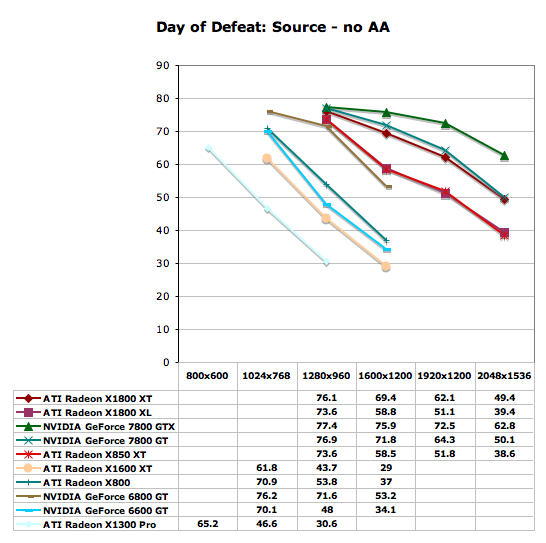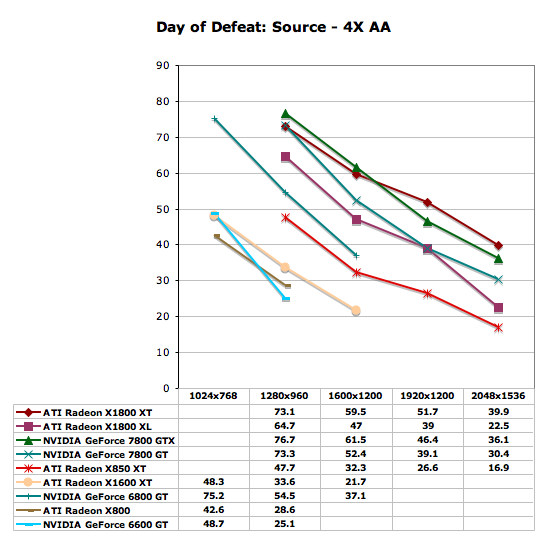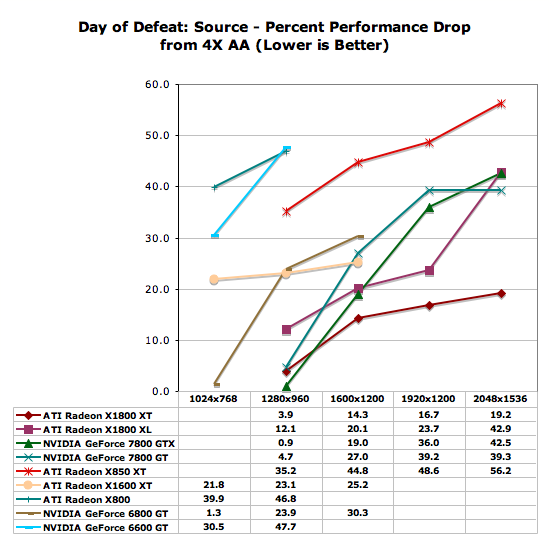ATI's X1000 Series: Extended Performance Testing
by Derek Wilson on October 7, 2005 10:15 AM EST- Posted in
- GPUs
Day of Defeat: Source Performance
Rather than test Half-Life 2 once again, we decided to use a game that pushed the engine further. The reworked Day of Defeat: Source takes 4 levels from the original game and adds not only the same brush up given to Counter Strike: Source, but HDR capabilities as well. The new Source engine supports games with and without HDR. The ability to use HDR is dependent on whether or not the art assets needed to do the job are available.
In order to push this test to the max, the highest settings possible were tested. This includes enabling the reflect all and full HDR options. Our first test was run with no antialiasing and trilinear filtering, and our second set of numbers was generated after 4x antialiasing and 8x anisotropic filtering were enabled.
From the looks of our graph, we hit a pretty hard CPU barrier near 80 frames per second. The 7800 GTX sticks the closest to this limit for the longest, but still can't help but fall off when pushing two to three megapixel resolutions. The 7800 GT manages to out-perform the X1800 XT, but more interestingly, the X850 XT and X1800 XL put up nearly identical numbers in this test. The X1300 Pro and the X1600 XT parallel each other as well, with the X1600 XT giving almost the same numbers as the X1300 Pro one resolution higher. The 6600 GT (and thus the 6800 GT as well) out-performs the X1600 XT pretty well.

Antialiasing changes the performance trends a bit, but at lower resolutions, we still see our higher end parts reaching up towards that 80 fps CPU limit. The biggest difference that we see here is that the X1000 series are able to gain the lead in some cases as resolution increases with AA enabled. The X1800 XT takes the lead from the 7800 GTX at 1920x1200 and at 2048x1536. The 7800 GT manages to hold its lead over the X1800 XL, but neither is playable at the highest resolution with 4xAA/8xAF enabled. The 6600 GT and X1600 XT manage to stop being playable at anything over 1024x768 with AA enabled. On those parts, gamers are better off just increasing the resolution to 1280x960 with no AA.

The 7800 series parts try to pretend that they scale as well as the X1800 series at 1600x1200 and below when enabling AA. The X850 XT scales worse than the rest of the high end, but this time, the X1600 XT is able to show that it handles the move to AA better than either of the X8xx parts test and better than the 6600 GT as well. The 6800 GT takes the hit from antialiasing better than the X1600 XT though.

Doom 3 showed NVIDIA hardware leading at every step of the way in our previous tests. Does anything change when looking at numbers with and without AA enabled?
Rather than test Half-Life 2 once again, we decided to use a game that pushed the engine further. The reworked Day of Defeat: Source takes 4 levels from the original game and adds not only the same brush up given to Counter Strike: Source, but HDR capabilities as well. The new Source engine supports games with and without HDR. The ability to use HDR is dependent on whether or not the art assets needed to do the job are available.
In order to push this test to the max, the highest settings possible were tested. This includes enabling the reflect all and full HDR options. Our first test was run with no antialiasing and trilinear filtering, and our second set of numbers was generated after 4x antialiasing and 8x anisotropic filtering were enabled.
From the looks of our graph, we hit a pretty hard CPU barrier near 80 frames per second. The 7800 GTX sticks the closest to this limit for the longest, but still can't help but fall off when pushing two to three megapixel resolutions. The 7800 GT manages to out-perform the X1800 XT, but more interestingly, the X850 XT and X1800 XL put up nearly identical numbers in this test. The X1300 Pro and the X1600 XT parallel each other as well, with the X1600 XT giving almost the same numbers as the X1300 Pro one resolution higher. The 6600 GT (and thus the 6800 GT as well) out-performs the X1600 XT pretty well.

Antialiasing changes the performance trends a bit, but at lower resolutions, we still see our higher end parts reaching up towards that 80 fps CPU limit. The biggest difference that we see here is that the X1000 series are able to gain the lead in some cases as resolution increases with AA enabled. The X1800 XT takes the lead from the 7800 GTX at 1920x1200 and at 2048x1536. The 7800 GT manages to hold its lead over the X1800 XL, but neither is playable at the highest resolution with 4xAA/8xAF enabled. The 6600 GT and X1600 XT manage to stop being playable at anything over 1024x768 with AA enabled. On those parts, gamers are better off just increasing the resolution to 1280x960 with no AA.

The 7800 series parts try to pretend that they scale as well as the X1800 series at 1600x1200 and below when enabling AA. The X850 XT scales worse than the rest of the high end, but this time, the X1600 XT is able to show that it handles the move to AA better than either of the X8xx parts test and better than the 6600 GT as well. The 6800 GT takes the hit from antialiasing better than the X1600 XT though.

Doom 3 showed NVIDIA hardware leading at every step of the way in our previous tests. Does anything change when looking at numbers with and without AA enabled?










93 Comments
View All Comments
waldo - Friday, October 7, 2005 - link
I have been one that has been critical of the video card reviews, and am pleasantly suprised with this review! Thanks for the work Derek, and I am sure the overtime it took to punch this together...I can only imagine the hours you had to pull to put this together. That is why I love AnandTech! Great site, and responsive to the readers! Cheers!DerekWilson - Friday, October 7, 2005 - link
Anything we can do to help :-)I am glad that this article was satisfactory, and I regret that we were unable to provide this ammount of coverage in our initial article.
Keep letting us know what you want and we will keep doing our best to deliver.
Thanks,
Derek Wilson
supafly - Friday, October 7, 2005 - link
Maybe I missed it, but what system are these tests being done on?The tests from "ATI's Late Response to G70 - Radeon X1800, X1600 and X1300" were using:
ATI Radeon Express 200 based system
AMD Athlon 64 FX-55
1GB DDR400 2:2:2:8
120 GB Seagate 7200.7 HD
600 W OCZ PowerStreams PSU
Is this one the same? I would be interested to see the same tests run on a NF4 motherboard.
supafly - Friday, October 7, 2005 - link
Ahh, I skipped over that last part.. " The test system that we employed is the one used for our initial tests of the hardware."I would still like to see it on a NF4 mobo.
photoguy99 - Friday, October 7, 2005 - link
Vista will have DirectX 10, which adds geometry shaders and other bits.The ATI cards will run vista of course, but do everything DX10 hardware is capable of.
photoguy99 - Saturday, October 8, 2005 - link
Sorry, I meant the new ATI cards will *not* be DX10 compatible.The biggest difference is DX10 will introduce geometry shaders which is a whole new architectural concept.
This is a big difference that will make the X1800XT seem out of date.
The question is when will it seem out of date. Another year for Vista to be released with DX10, and then how long before a game not only has a DX10 rendering path, but has it do something interesting?
Hard to say - it could be the games with a DX10 rendering path show little difference, it could be you see a lot more geometry detail in UT2007.
Make your predications, spend your money, good luck.
Chadder007 - Friday, October 7, 2005 - link
Sooo...the new ATI's are pre-DX10 compliant? If so, what about the new Nvidia parts?DerekWilson - Friday, October 7, 2005 - link
This is not true -- DX10 will specific functions will not be compatible with either new ATI or NVIDIA hardware.Games written for Vista will be required to support DX9 initially and DX10 will be the advanced featureset. This will be to support hardware from the Radeon 9700 and GeFroce FX series through the Radeon X1K and 7800 series.
There is currently no hardware that is DX10 capable.
Xenoterranos - Saturday, October 8, 2005 - link
Im just hoping NVIDIA doesn't go braindead again ont he DX compliance. I'm still stuck with a non-fully compatible 5900 card. It runs HL2 very well even at high settings, but I know Im missing all the pretty DX9 stuff. I probably won't get another card untill DX10 hits, and then buy the first card that fully supports it.JarredWalton - Saturday, October 8, 2005 - link
Well, part of that is marketing. DX9 graphics are better than DX8.1, but it's not a massive difference on many games. Far Cry is almost entirely DX8.1, and other than a slight change to the water, you're missing nothing but performance.It's like the SM2.0 vs. SM3.0 debate. SM3.0 does allow for more complex coding, but mostly it just makes it so that the developers don't have to unroll loops. HDR, instancing, displacement mapping, etc. can all be done with SM2.0; it's just more difficult to accomplish and may not perform quite as fast.
Okay, I haven't ever coded SM2.0 or 3.0 (advanced graphics programming is beyond my skill level), but that's how I understand things to be. The SM3.0 brouhaha was courtesy of NVIDIA marketing, just like the full DX9 hubub was from ATI marketing. Anyway, MS and Intel have proven repeatedly that marketing is at least as important as technology.